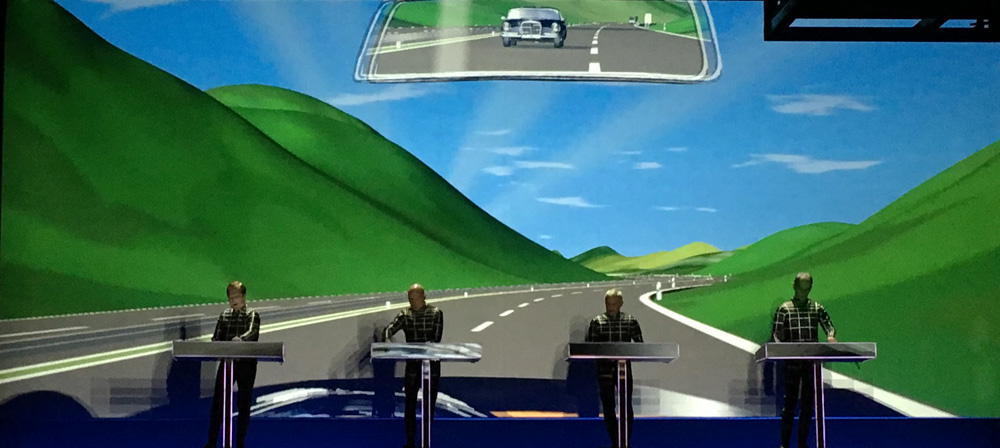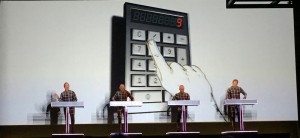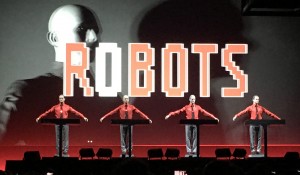Kraftwerk's Electronic Time Machine
 Even though they haven’t released any new music since 2003’s Tour De France and they retain only one original member, Kraftwerk continues to enthrall audiences in a way that may be even more powerful than their glory years between 1978’s Trans-Europe Express and 1981’s Computer World. They are a band that eschews all the conventions of rock and pop. There are no guitars, drums, bass or conventional keyboards. There’s no “showmanship” per se. There’s no front-person and very little indication of movement from the four musicians sitting behind plinth like stands housing who knows what technology. Despite the absence of any popular music signifiers, they filled the overstuffed Electric Factory in Philadelphia, vacuum packing them in right to the back door.
Even though they haven’t released any new music since 2003’s Tour De France and they retain only one original member, Kraftwerk continues to enthrall audiences in a way that may be even more powerful than their glory years between 1978’s Trans-Europe Express and 1981’s Computer World. They are a band that eschews all the conventions of rock and pop. There are no guitars, drums, bass or conventional keyboards. There’s no “showmanship” per se. There’s no front-person and very little indication of movement from the four musicians sitting behind plinth like stands housing who knows what technology. Despite the absence of any popular music signifiers, they filled the overstuffed Electric Factory in Philadelphia, vacuum packing them in right to the back door.
Kraftwerk was in the original wave of so-called Krautrock and they gained greater popularity and outlasted most of their peers. In their early incarnation with albums like Kraftwerk, Kraftwerk 2 and Ralf and Florian, they were experimentalists working with rudimentary electronic instruments, many of them custom-built. But with Autobahn, they became something of a pop novelty. Next to artists like Can, Klaus Schulze, Cluster and Tangerine Dream, Kraftwerk came off as contrived artifice, playing off the Man-Machine paradox and cutting their hair long before they had to, decked themselves out in the attire of young German technocrats.
 As the lights went down, a 5-minute alap of vaguely repetitive bloops and bleeps played while a pixilated image of the band was projected on the screen. The curtains parted and the quartet finally appeared dressed in Tron-like body suits. The countdown of “Numbers” sounded out and the 3D experience was established with rows of digits shifting through various permutations that projected out into the audience, usually ending up in the “Eins,Zwei, Drei…” of the lyrics. It was the start of a non-stop trip through Kraftwerk’s catalog from Autobahn through to Tour De France. Other than the opening melody of “Trans-Europe Express” which is lifted from their early track, “Ruckzuck”, they haven’t played music from their first three albums in decades.
As the lights went down, a 5-minute alap of vaguely repetitive bloops and bleeps played while a pixilated image of the band was projected on the screen. The curtains parted and the quartet finally appeared dressed in Tron-like body suits. The countdown of “Numbers” sounded out and the 3D experience was established with rows of digits shifting through various permutations that projected out into the audience, usually ending up in the “Eins,Zwei, Drei…” of the lyrics. It was the start of a non-stop trip through Kraftwerk’s catalog from Autobahn through to Tour De France. Other than the opening melody of “Trans-Europe Express” which is lifted from their early track, “Ruckzuck”, they haven’t played music from their first three albums in decades.
They played most of Computer World, steaming through the chromium finish, and robot vocals of tracks like the title piece and “Computer Love” as well as the goofy nerd anthems, “It’s More Fun to Compute” and “Pocket Calculator.” Kraftwerk’s take on technology was always retro, even when it was state of the art, so a work like “Pocket Calculator” still has the same geeky charm it did back in 1981.
The visuals were images the band has employed for a while, refitted with 3-D technology in 2009. They spun from abstract geometric patterns to sing-along lyrics and archival film images. They engaged in old-school 3D trickery for songs like “Spacelab” when a satellite’s antenna array projected all the way to the back of the house, followed by a flying saucer that landed in front of a full screen image of the Electric Factory, which looked as trashy as it does in real life.
Some of the most effective were animations based on Kraftwerk album covers like Autobahn, taking that cover image with a perspective from inside a VW Beetle and sending it rolling down a cartoon autobahn.
 It was difficult to see what the band was playing, if anything. Certainly, they weren’t doing enough to trigger all the music we were hearing, but there were moments when it felt like they might be noodle-jamming over the grooves. I saw Kraftwerk on their first US tour in 1975 on the heels of Autobahn. It seemed like the quartet was playing live a lot more then, seated at synthesizers like the Minimoog and Arp Odyssey, beating custom electronic percussion and vibraphone. Founding member Florian Schneider, who left i 2008, even played electric flute. But now, everything is invisible to the audience. If it seems like Kraftwerk could probably just play a CD and let the visuals run, that’s likely true, an impression the band famously plays upon in their first encore. The curtains parted to robotic versions of the band, making stiff, minimal movements while the song “Robots’ played. (Check out this behind-the-band video to see what they’re really up to.) It’s more like an art installation than a concert.
It was difficult to see what the band was playing, if anything. Certainly, they weren’t doing enough to trigger all the music we were hearing, but there were moments when it felt like they might be noodle-jamming over the grooves. I saw Kraftwerk on their first US tour in 1975 on the heels of Autobahn. It seemed like the quartet was playing live a lot more then, seated at synthesizers like the Minimoog and Arp Odyssey, beating custom electronic percussion and vibraphone. Founding member Florian Schneider, who left i 2008, even played electric flute. But now, everything is invisible to the audience. If it seems like Kraftwerk could probably just play a CD and let the visuals run, that’s likely true, an impression the band famously plays upon in their first encore. The curtains parted to robotic versions of the band, making stiff, minimal movements while the song “Robots’ played. (Check out this behind-the-band video to see what they’re really up to.) It’s more like an art installation than a concert.
For all their reputed love of disco music and the abundant sampling of their music that has taken place in R&B, Rap and House music, beginning with Afrika Bambaata’s use of “Trans-Europe Express,” there is still little that’s danceable in Kraftwerk’s electro-hymns. Other than the truly novelty songs, theirs is more the music of trance, repetitive sequencer grooves that propel you through their often electronic space. Even their lyrics are like machine mantras for the digital age.
Kraftwerk hasn’t produced any new music in 12 years and only two slight albums in the last 34 years, which makes these tours more like an oldies tour. Yet, it’s striking how timeless the music is, how robust their sonic palette remains and how sly their humor is, something usually lacking in this genre.
With the 2015 deaths of Krautrock figures Edgar Froese of Tangerine Dream and Dieter Moebius of Cluster/Harmonia, this entire generation of pioneering musicians is nearing the end of their time on the planet. So it’s bittersweet seeing Kraftwerk on what seems to be an endless victory lap. Founding member Ralf Hütter, at 69, is slightly younger than many of them, but you have to wonder how long he can keep going. But then, there are always the robots.
~John Diliberto

Very nice review. I’ve been into this kind of music for most of my life.